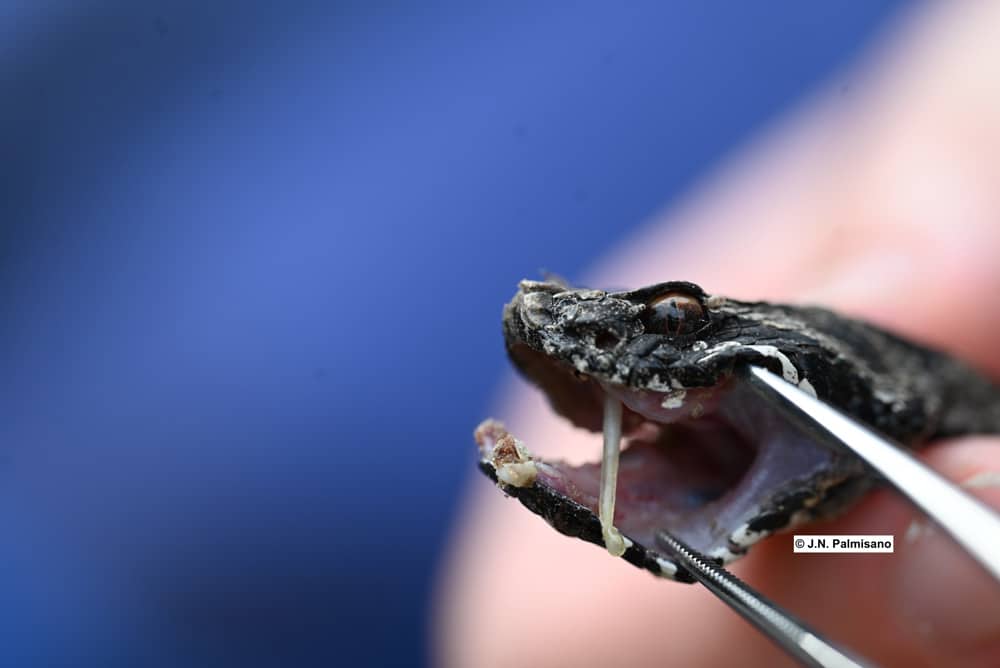Also known as snake lungworm, the parasite may soon be in Georgia or other neighboring states.
Snake lungworm (Raillietiella orientalis), an invasive parasite that is commonly found in the Burmese python (Python bivittatus) in Southeast Asia, is now in 14 counties in Florida, according to a study published by BioInvasions Records.

An anterior view of a Raillietiella orientalis adult with the four characteristic hooks and buccal cadre. Raillietiella orientalis has a flattened, triangular head with two small anterior hooks and two larger posterior hooks Photo by Jenna Palmisano.
The parasite, native to Southeast Asia and Africa, has spread rapidly in the state since it was first identified in South Florida back in 2012. What is notable in this study, according to the authors, is that the parasite was found in 13 Florida counties just last year. This, according to the researchers, show the prevalence and speed in which the parasite moves amongst the reptile and amphibian population in the state. Raillietiella orientalis infects the lungs of their hosts, which can ultimately cause death.
Asian Lungworm Found In Burmese Pythons Affecting Florida Native Snakes
The parasite is spread through multiple intermediate hosts. One mode of transmission is via cockroaches, which eat the egg laden feces. Those roaches are then consumed by amphibians and lizards, including southern toads (Anaxyrus terrestris), southern leopard frogs (Rana sphenocephala) and Cuban brown anoles (Anolis sagrei). While the researchers say the parasites uses snake as a definitive host, researchers have found adult R. orientalis in tokay geckos (Gekko gecko) and the Argentine black and white tegu (Salvator merianae), two invasive lizards that have become established in the state.

This pygmy rattlesnake had been struck and killed, probably by a bicycle. Two of the invasive lungworms were found exiting its mouth and upon dissecting the venomous snake, two more adults were found inside. Photo by Jenna Palmisano
Snakes Infected By Raillietiella orientalis
The parasite has infected 18 native snake species of the Agkistrodon, Coluber, Crotalus, Drymarchon, Farancia, Lampropeltis, Masticophis, Nerodia, Pantherophis, Sistrurus, and Thamnophis genuses. In 2023, the researchers dissected three native snakes that were acquired from a reptile supplier in South Florida. The snakes, two garter snakes (Thamnophis sirtalis) and a scarlet kingsnake (Lampropeltis elapsoides) were of unknown origin, but the researchers speculate that based on the emaciated and anorexic condition of the snakes and external lesions, the snakes were wild caught. The presence of Raillietiella orientalis was documented in these three snakes, ranging from three and 36 parasites in the garter snakes and nine parasites in the scarlet kingsnake.
Venomous Coral Snake Successfully Operated for Pentastome Parasites Is OCIC Ambassador
The researchers say that human activity is likely facilitating the rapid geographic range expansion of the parasite. This may be occurring by unknowingly moving infected snakes to other parts of the country or as in the case of Anolis sagrei, as a food item for captive animals. The researchers are calling for a management strategy to mitigate the spread as well as biosecurity regulations for wild caught species brought into captivity.
The complete paper, “Rapid spread of the invasive pentastome Raillietiella orientalis (Hett, 1915) in 14 new Florida counties and in pet trade snakes” can be read on the BioInvasions Records website.


